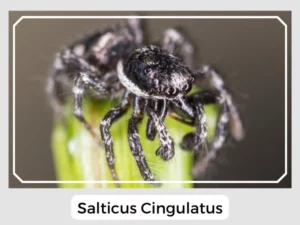Did you know there’s a group of jumping spiders called Salticus? There are 48 different types of them! A long time ago, they had a different name, but in 1955, a spider expert named Pierre Bonnet gave them their own special group.

Some species lay about 5 – 15 eggs within a silken sac, closely guarded by females.
Spiderlings go through several molt phases.
These spiders do not make any webs for catching their prey but may use silk to make temporary shelters to take rest.
Yes, Salticus spiders have venom, but it’s mainly to help them catch their food. For humans, it’s not harmful.
Salticus spiders can bite, but it’s rare. If they do, it’s because they’re scared. It’s like a tiny pinch and usually not bothersome for most folks.
Salticus spiders play a crucial role in controlling the population of arthropods and other spiders, contributing to the ecological balance. They are diurnal hunters, relying on their excellent vision and agility to stalk and pounce on prey. Their preference for sunny habitats such as tree trunks and rocks near woodlands and heathlands makes them a common sight in these areas.
Natural Predators and Prey-Predator Dynamics: While Salticus spiders are proficient hunters, they are not without their own natural predators. Birds and larger spiders pose a significant threat, creating a balanced predator-prey dynamic in their habitats.
Relationship with Humans: Salticus spiders, often found in sunny outdoor locations, occasionally venture into human dwellings. Though their presence may be startling to some, it is essential to recognize their beneficial role in controlling pest populations, making them a natural ally in maintaining ecological stability.
| Other Names | Zebra spiders |
| Distribution | South Africa, Mexico, Brazil, Afghanistan, France, Tunisia, Greece, Italy, Hungary, e.t.c |
| Habitat | Tree trunks and rocks, especially located near sunny areas, woodlands, and heathlands. |
| Diet | Arthropods and other spiders |
| Lifespan | 2-3 years on average, but some species can live longer |
In summary, the Salticus spiders, with their distinctive appearance and remarkable jumping abilities, offer a glimpse into the diverse and intricate world of arachnids.
Did you know there’s a group of jumping spiders called Salticus? There are 48 different types of them! A long time ago, they had a different name, but in 1955, a spider expert named Pierre Bonnet gave them their own special group.

Some species lay about 5 – 15 eggs within a silken sac, closely guarded by females.
Spiderlings go through several molt phases.
These spiders do not make any webs for catching their prey but may use silk to make temporary shelters to take rest.
Yes, Salticus spiders have venom, but it’s mainly to help them catch their food. For humans, it’s not harmful.
Salticus spiders can bite, but it’s rare. If they do, it’s because they’re scared. It’s like a tiny pinch and usually not bothersome for most folks.
Salticus spiders play a crucial role in controlling the population of arthropods and other spiders, contributing to the ecological balance. They are diurnal hunters, relying on their excellent vision and agility to stalk and pounce on prey. Their preference for sunny habitats such as tree trunks and rocks near woodlands and heathlands makes them a common sight in these areas.
Natural Predators and Prey-Predator Dynamics: While Salticus spiders are proficient hunters, they are not without their own natural predators. Birds and larger spiders pose a significant threat, creating a balanced predator-prey dynamic in their habitats.
Relationship with Humans: Salticus spiders, often found in sunny outdoor locations, occasionally venture into human dwellings. Though their presence may be startling to some, it is essential to recognize their beneficial role in controlling pest populations, making them a natural ally in maintaining ecological stability.
| Other Names | Zebra spiders |
| Distribution | South Africa, Mexico, Brazil, Afghanistan, France, Tunisia, Greece, Italy, Hungary, e.t.c |
| Habitat | Tree trunks and rocks, especially located near sunny areas, woodlands, and heathlands. |
| Diet | Arthropods and other spiders |
| Lifespan | 2-3 years on average, but some species can live longer |
In summary, the Salticus spiders, with their distinctive appearance and remarkable jumping abilities, offer a glimpse into the diverse and intricate world of arachnids.